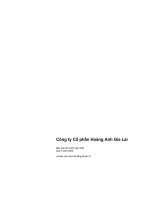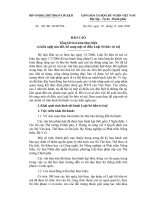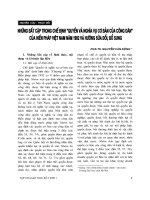ISA 13 nghĩa vụ báo cáo của KTV
Bạn đang xem bản rút gọn của tài liệu. Xem và tải ngay bản đầy đủ của tài liệu tại đây (7.09 MB, 39 trang )
Chapter 13
The Auditor’s Reporting
Obligations
Copyright 2006 McGraw-Hill Australia Pty Ltd
13-
Learning Objective 1:
Obligations to Report
•
The objective of an audit of the financial report is to
enable the auditor to express an opinion whether the
financial report is prepared, in all material respects, in
accordance with an applicable financial reporting
framework.
• The auditor also has an obligation to form a conclusion
as to whether the financial reports have been prepared
using Australian accounting standards issued by the
AASB.
Copyright 2006 McGraw-Hill Australia Pty Ltd
Revised PPTs t/a Auditing and Assurance Services in Australia 3e by Grant Gay and Roger Simnett
Slides prepared by Roger Simnett
13-2
Obligations to report (Cont.)
•
S.307 of the Corporations Act 2001 requires the auditor
to form an opinion as to:
(a)
Whether the financial report is in accordance with the
Act, including:
(i) section 296 or 304 (compliance with accounting
standards); and
(ii) section 297 or 305 (true and fair view); and
(aa) if the financial report includes additional information …
(to give a true and fair view of the financial position
and
performance) – whether the inclusion of that
information was necessary to give the true and fair
view required by section 297 or 305; and
Copyright 2006 McGraw-Hill Australia Pty Ltd
Revised PPTs t/a Auditing and Assurance Services in Australia 3e by Grant Gay and Roger Simnett
Slides prepared by Roger Simnett
13-3
Obligations to report (Cont.)
•
(S.307 cont.)
(b) whether the auditor has been given all
information, explanation and assistance necessary for
the conduct of the audit; and
(c) whether the company, registered scheme or
disclosing entity has kept financial records
sufficient to enable a financial report to be
prepared and audited; and
(d) whether the company, registered scheme or
disclosing entity has kept other records and
registers as required by this Act.
Copyright 2006 McGraw-Hill Australia Pty Ltd
Revised PPTs t/a Auditing and Assurance Services in Australia 3e by Grant Gay and Roger Simnett
Slides prepared by Roger Simnett
13-4
Obligations to report (Cont.)
•
The Corporations Act 2001 (s. 308(1)) also clearly
specifies that the audit report shall state the auditor’s
opinion in relation to:
–
–
section (a) (i) of s. 307(1): - compliance with accounting
standards, and
section (a) (ii) of s. 307(1): - true and fair view
Copyright 2006 McGraw-Hill Australia Pty Ltd
Revised PPTs t/a Auditing and Assurance Services in Australia 3e by Grant Gay and Roger Simnett
Slides prepared by Roger Simnett
13-5
Who the auditor has an obligation to report
to
•
The governing body and members
• Management and the board of directors
• Australian Securities and Investments Commission
(ASIC)
Copyright 2006 McGraw-Hill Australia Pty Ltd
Revised PPTs t/a Auditing and Assurance Services in Australia 3e by Grant Gay and Roger Simnett
Slides prepared by Roger Simnett
13-6
Learning Objective 2:
True and Fair View
•
Differences in terminology for:
–
–
AUS 702/ASA 700 (ISA 700) — whether financial report
presents fairly in accordance with applicable accounting
standards and other mandatory professional reporting
requirements; and
Corporations Act 2001 audits — whether the accounts are
drawn up so as to give a true and fair view.
Copyright 2006 McGraw-Hill Australia Pty Ltd
Revised PPTs t/a Auditing and Assurance Services in Australia 3e by Grant Gay and Roger Simnett
Slides prepared by Roger Simnett
13-7
Interpretations of true and fair
•
Technical interpretation; and
• Literal interpretation.
Copyright 2006 McGraw-Hill Australia Pty Ltd
Revised PPTs t/a Auditing and Assurance Services in Australia 3e by Grant Gay and Roger Simnett
Slides prepared by Roger Simnett
13-8
Technical interpretation
•
Financial report will constitute a true and fair view when
prepared in accordance with generally accepted
accounting principles (GAAP).
• Thus, where an accounting standard has not been
complied with, financial reports will not present a true
and fair view.
Copyright 2006 McGraw-Hill Australia Pty Ltd
Revised PPTs t/a Auditing and Assurance Services in Australia 3e by Grant Gay and Roger Simnett
Slides prepared by Roger Simnett
13-9
Literal interpretation
•
View presented by financial information is consistent
with auditor’s knowledge of the entity.
• Allows for non-compliance with GAAP where
compliance would result in view presented by financial
report inconsistent with auditor’s knowledge of the entity
• Standard-setters have effectively adopted a technical
interpretation by requiring any “true and fair” override to
be in the notes to accounts (these are rare in practice)
rather than being reflected in the balance sheet and
income statement.
Copyright 2006 McGraw-Hill Australia Pty Ltd
Revised PPTs t/a Auditing and Assurance Services in Australia 3e by Grant Gay and Roger Simnett
Slides prepared by Roger Simnett
13-10
Audit Reporting Standards Developments
from 1 July 2006
For audit reporting periods commencing on or after 1 July 2006,
two reporting standards will replace AUS 702.
These are:
• ASA 700 (ISA 700) The Auditor’s Report on a General
Purpose Financial Report
• ASA 701 (ISA 701) Modifications to the Auditor’s Report
ASA 700 will cover unqualified opinions on a general purpose
financial report, while ASA 701 will cover all modifications to
the audit report.
• Emphasis of matter opinions are contained in ASA 701 as
they result in modifications to the auditors’ report, even if they
do not result in modifications to the auditor’s opinion.
• The three types of qualified reports outlined on previous slide
all result in modifications (qualifications) to the auditor’s
report.
Copyright 2006 McGraw-Hill Australia Pty Ltd
Revised PPTs t/a Auditing and Assurance Services in Australia 3e by Grant Gay and Roger Simnett
Slides prepared by Roger Simnett
13-11
Learning Objective 3:
Structure of the Audit Report
Title
Addressee
Scope section
Qualification paragraph (where required)
Opinion paragraph
Emphasis of matter section (where required)
Auditor’s signature
Address
Date of audit report.
(Note that ASA 700 divides the scope section into an introductory
paragraph, a paragraph on the responsibility of those charged with
governance for the financial report and a paragraph on the Auditor’s
responsibility. It also contains an other reporting responsibilities
paragraph just before the auditor’s signature, for reporting
responsibilities on other than the financial report.)
•
•
•
•
•
•
•
•
•
Copyright 2006 McGraw-Hill Australia Pty Ltd
Revised PPTs t/a Auditing and Assurance Services in Australia 3e by Grant Gay and Roger Simnett
Slides prepared by Roger Simnett
13-12
Example: Unqualified audit report
Exhibit 13.1 Example of an unqualified audit report (p. 608)
Copyright 2006 McGraw-Hill Australia Pty Ltd
Revised PPTs t/a Auditing and Assurance Services in Australia 3e by Grant Gay and Roger Simnett
Slides prepared by Roger Simnett
13-13
Example: Unqualified audit report
Copyright 2006 McGraw-Hill Australia Pty Ltd
Revised PPTs t/a Auditing and Assurance Services in Australia 3e by Grant Gay and Roger Simnett
Slides prepared by Roger Simnett
13-14
Example: Unqualified audit report
Copyright 2006 McGraw-Hill Australia Pty Ltd
Revised PPTs t/a Auditing and Assurance Services in Australia 3e by Grant Gay and Roger Simnett
Slides prepared by Roger Simnett
13-15
Qualitative criteria of audit report
•
•
•
•
•
•
Relevance;
Reliability;
Any explanatory information included, such as in
qualification, should be material;
Timeliness;
Comparability (standard form reports encouraged); and
Understandability.
Copyright 2006 McGraw-Hill Australia Pty Ltd
Revised PPTs t/a Auditing and Assurance Services in Australia 3e by Grant Gay and Roger Simnett
Slides prepared by Roger Simnett
13-16
Learning Objective 4:
Types of Audit Opinions
• Unqualified
–
–
An unqualified opinion
An unqualified opinion
with an emphasis of
matter
Unmodified
Modified
• Qualified
–
–
–
An ‘except for’ opinion Modified
Modified
An adverse opinion
An inability to form an Modified
opinion
Copyright 2006 McGraw-Hill Australia Pty Ltd
Revised PPTs t/a Auditing and Assurance Services in Australia 3e by Grant Gay and Roger Simnett
Slides prepared by Roger Simnett
13-17
Unqualified opinion
•
Expressed when auditor is satisfied in all material
respects that financial report is presented fairly in
accordance with:
–
–
–
Applicable accounting standards and UIG Abstracts; and
Relevant statutory and other requirements.
Most audit opinions given are unqualified (currently,
approximately 97% of listed companies).
Copyright 2006 McGraw-Hill Australia Pty Ltd
Revised PPTs t/a Auditing and Assurance Services in Australia 3e by Grant Gay and Roger Simnett
Slides prepared by Roger Simnett
13-18
‘Except for’ opinion
•
For audits commencing on or after 1 July 2006, ‘except
for’ opinions are referred to as qualified opinions (ASA
701/ ISA 701). This brings Australian auditing standards
in line with international auditing standards.
• Issued when auditor has reservation about a specific
matter or matters, but apart from these specific matters
the remainder of financial report can be relied upon.
• Communicates that users can rely on majority of
financial report but need to adjust financial information
for matter(s) highlighted by auditor.
• Major type of qualification in practice.
Copyright 2006 McGraw-Hill Australia Pty Ltd
Revised PPTs t/a Auditing and Assurance Services in Australia 3e by Grant Gay and Roger Simnett
Slides prepared by Roger Simnett
13-19
Example of qualification and qualified opinion
paragraph for an ‘except for’ opinion
Exhibit 13.2 Example of the qualification and qualified audit opinion paragraphs for an except for opinion (p. 614)
Copyright 2006 McGraw-Hill Australia Pty Ltd
Revised PPTs t/a Auditing and Assurance Services in Australia 3e by Grant Gay and Roger Simnett
Slides prepared by Roger Simnett
13-20
Example of qualification and qualified opinion
paragraph for an ‘except for’ opinion
Exhibit 13.2 Example of the qualification and qualified audit opinion paragraphs for an except for opinion (p. 614)
Copyright 2006 McGraw-Hill Australia Pty Ltd
Revised PPTs t/a Auditing and Assurance Services in Australia 3e by Grant Gay and Roger Simnett
Slides prepared by Roger Simnett
13-21
Adverse opinion
•
Expressed when auditor’s reservations are of such
magnitude or are so pervasive that they believe
financial report, taken as a whole, is misleading and of
little use to addressee of the audit report.
• This communicates that no reliance should be placed
on financial report.
• It is extremely rare in practice.
Copyright 2006 McGraw-Hill Australia Pty Ltd
Revised PPTs t/a Auditing and Assurance Services in Australia 3e by Grant Gay and Roger Simnett
Slides prepared by Roger Simnett
13-22
Example of qualification and qualified opinion paragraph
for adverse opinion
Exhibit 13.3 Example of the qualification and qualified audit opinion paragraphs for an adverse opinion (p.615)
Copyright 2006 McGraw-Hill Australia Pty Ltd
Revised PPTs t/a Auditing and Assurance Services in Australia 3e by Grant Gay and Roger Simnett
Slides prepared by Roger Simnett
13-23
Inability to form an opinion
•
Expressed when auditor is unable to obtain adequate
evidence to form an opinion on issues, the possible
effects of which are material or pervasive to financial
report taken as a whole.
• Communicates that the auditor is unsure whether
financial report as a whole is reliable.
• Very rare in practice.
Copyright 2006 McGraw-Hill Australia Pty Ltd
Revised PPTs t/a Auditing and Assurance Services in Australia 3e by Grant Gay and Roger Simnett
Slides prepared by Roger Simnett
13-24
Example of qualified audit opinion paragraph for a statement of
inability for form an opinion
Copyright 2006 McGraw-Hill Australia Pty Ltd
Revised PPTs t/a Auditing and Assurance Services in Australia 3e by Grant Gay and Roger Simnett
Slides prepared by Roger Simnett
13-25









